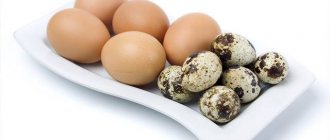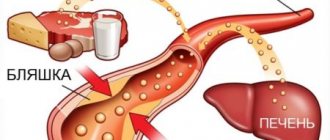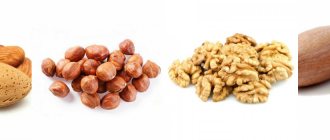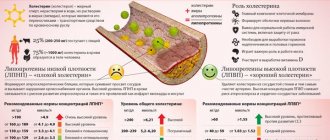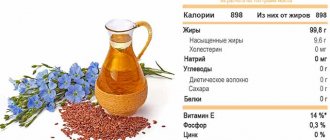The question of the benefits and harms of meat is quite acute, since if you make the wrong choice, you can develop vascular atherosclerosis. Of course, you can become the owner of this disease without excessive consumption of this product, but you still need to know which meat has more cholesterol.
Because of this substance, doctors consider the meat of some animals to be harmful and even dangerous. However, it is necessary to include meat in the diet, because it contains vitamins, micro- and macroelements, amino acids, and easily digestible proteins. To prevent a person from suffering from excess cholesterol, it is worth learning the secrets of choosing this product.
The effect of cholesterol on the body
Cholesterol is the main element of fat metabolism, the synthesis of which occurs to a greater extent in the liver (about 80%) and partially comes with food (20%).
A sufficient amount of cholesterol is necessary for the production of bile acids, proper metabolism, the synthesis of vitamin D and steroid hormones (minerals and glucocorticoids).
Cholesterol is the content of the myelin sheath of nerves and contributes to the proper transmission of nerve impulses. Cholesterol is also part of the structure of cellular structures and is responsible for their elasticity and permeability.
An increase in cholesterol concentration leads to the development of atherosclerotic vascular damage and the formation of the following diseases:
- Coronary heart disease and hypertension (threat of acute myocardial infarction).
- Ischemia of cerebral vessels (threat of hemorrhagic/ischemic stroke).
- Ischemia of the kidneys and intestines (possible thrombosis of intestinal vessels, development of chronic renal failure).
- Vascular ischemia of the lower extremities (risk of developing trophic ulcers, gangrene of the legs).
The recommended daily requirement for cholesterol is about 250 - 300 mg, necessary for the general functioning of the body, regardless of the person’s age and gender.
Where is the most cholesterol?
Beneficial features
When the conversation turns to the benefits of meat, people are divided into two opposing camps. Most people love to eat delicious food and cannot imagine their life without a flavorful steak or juicy cutlets. In addition to the undeniable advantage of excellent taste, the product has the following beneficial properties:
- Meat is the leader in protein content. It contains a complete list of amino acids, including essential ones, which cannot be synthesized in the human body. Polypeptide chains, consisting of many amino acid residues, are the building material for cells of all organs and systems. It is especially important to have sufficient protein intake with food in childhood, during pregnancy and lactation, as well as during the rehabilitation period after severe somatic pathology.
- High levels of microelements are determined in various types of meat:
- iron, responsible for binding oxygen molecules to red blood cells;
- calcium, responsible for bone growth and strengthening;
- potassium, together with sodium, carrying out metabolic processes between cells;
- zinc, which regulates the functioning of the immune system;
- magnesium and manganese, which are catalysts for most chemical reactions in the body.
- Vitamin A controls the functioning of the body’s nervous system and promotes sharp vision;
- vitamin D regulates the functioning of immune cells;
- B vitamins, in particular B12, affect the functioning of the brain and spinal cord, as well as the hematopoietic organs.
It has been noted that the complete exclusion of meat from the diet and long-term vegetarian nutrition can lead to the development of iron deficiency and vitamin B12 deficiency anemia.
Benefits of eating meat
Meat dishes are part of the daily nutritious diet of most people, are combined with various foods and have the following beneficial qualities:
- Meat contains all the amino acids necessary for the body, which are absent in proteins of plant origin, are not produced by the liver and are important for the biosynthesis of its own proteins. Proteins form the basis of cells, are a storehouse of energy, play the role of neurotransmitters (participate in the transmission of nerve impulses), and regulate the function of vitamins and minerals.
- Meat is a donor of L-carnitine and coenzyme Q 10, substances necessary for the normal functioning of the heart muscle.
- Meat contains vitamins B6 and B12, which are essential for the functioning of the central and peripheral nervous system, hematopoietic organs and which are donors of methyl groups (antioxidants responsible for the body’s response to stress, involved in tissue detoxification and having an anti-inflammatory effect).
- Creatine contained in meat is needed for energy metabolism in muscle and nerve cells. Also, creatine slows down the accumulation of lipofuscin pigment - a marker of aging and wear and tear of the body, has a positive effect on mental abilities and inhibits the progression of Parkinson's disease.
- Heme iron (found in “dark” meat) is very well absorbed by the body and is necessary for people suffering from anemia.
- Meat includes multiple trace elements: potassium, calcium, zinc, magnesium, manganese.
What are the benefits of eating meat?
Harm
Vegetarianism is becoming popular at the moment.
This direction completely excludes the consumption of meat, not only for ethical and religious reasons, but also based on the medical disadvantages of consuming this product:
- Meat products contain a high concentration of cholesterol , which is directly proportional to the part and type of meat and culinary processing.
- Meat is difficult to process and lingers in the gastrointestinal tract for a long time due to lack of fiber. That is why, after eating meat dishes, there is heaviness and discomfort in the abdominal area.
- Meat from animals raised under conditions of accelerated growth contains thyroid and sex hormones, which will disrupt the human hormonal balance and negatively affect health.
- Eating meat products is contraindicated for gout due to their high protein content.
Is meat harmful?
The meat of animals for whose growth food additives were used has a negative effect on the body.
Meat products are not only healthy, they also have disadvantages. They lack fiber, which makes them difficult to digest. In addition, meat contains a lot of cholesterol and fat. It is impossible to give an accurate assessment of cholesterol concentration, since its number is directly related to the type of animal, the conditions of its feeding and maintenance. The harmful effects on the body are also enhanced by the use of hormones that accelerate the growth of animals, harmful food additives for feeding livestock, as well as dyes that make products look attractive.
Chemical composition
The main part of meat is muscle tissue, which contains:
- Water 70 -75% . The amount of water depends on the age and fatness of the animal.
- Proteins 18 – 20% . Complete proteins (myosin, albumin, globulin, myogen) and incomplete (elastin, collagen).
- Fats 3 – 5% , of which saturated, “harmful” fats are about 45 – 50%.
- Carbohydrates 0.025 – 0.05% . The main carbohydrate in meat is glycogen, which affects the stage of meat ripening.
- Nitrogenous substances 1.5 - 1.7% stimulate appetite and provide meat and meat broths with a specific pleasant taste and aroma.
- Minerals 0.8 – 1.5% (iron, potassium, sodium, phosphorus salts).
The main part of meat is muscle tissue
Pork
The amount of cholesterol per 100 grams of pork is 100 mg. Pork is the most popular and frequently consumed type of meat. Pork is consumed in the form of freshly prepared dishes, canned food and smoked products, and cooked on the grill.
Energy value of the product (per 100 grams):
- Amount of protein 27 grams;
- Amount of fat 13 grams;
- Amount of carbohydrates 0 grams;
- Calorie content 250 kcal.
To reduce cholesterol consumption with pork, it is recommended:
- Choose leaner meat, remove excess fat and tendons.
- When preparing meat, give preference to boiling, stewing, baking, or steaming.
- The daily rate of meat consumption is no more than 200 - 250 grams.
- People with hypercholesterolemia are recommended to eat pork no more than 4 times a month.
Content of cholesterol and saturated fatty acids in different parts of pork (per 100 grams of product).
| Pork product | Amount of cholesterol, mg | Amount of EFAs, mg |
| Brisket | 80 | 6 |
| Brain | 2200 | 3 |
| Liver | 140 | 3 |
| Kidneys | 310 | 2 |
| Lungs | 1000 | 4 |
| Language | 55 | 2 |
Pork
Beef
It is known that beef has much less cholesterol than pork. High-quality beef is red in color and has a fibrous, marbled structure.
Nutritional value of the product (per 100 grams):
- Proteins 19 grams;
- Fat 18 grams;
- Carbohydrates 0 grams;
- Calorie content 155 kcal.
To reduce the amount of cholesterol consumed, you should follow the same rules when cooking pork. It is necessary to take into account that when consuming “old” meat (dark red in color and hard when pressed), digestibility and digestion become more difficult.
Individuals with high levels of cholesterol in the blood are not recommended to consume beef by-products; do not exceed the daily intake of 250-300 grams (we are talking about beef fillet).
Table of cholesterol and saturated fatty acids content in beef (per 100 grams of product).
| Beef product | Amount of cholesterol, mg | Amount of EFAs, mg |
| Fillet | 62 | 1 |
| Brain | 3000 | 2 |
| Liver | 300-400 | 2 |
| Kidneys | 320 | 1 |
| Language | 90 | 3 |
Beef
Veal
Veal is the meat of a young calf, which differs from beef in its tenderness, dietary quality and the fact that it has less fat.
This type of meat is special because it has exceptional extractive substances that increase the concentration of gastric juice and improve the digestion process.
Therefore, veal is recommended for people with a low concentration of gastric juice, or for hypoacid gastritis/stomach ulcers. Veal broths are recommended for use in cases of severe illness and for elderly people.
Veal dishes are an excellent source of protein, vitamins and minerals for pregnant women, nursing mothers and children.
Tender steamed veal cutlets or boiled meat are an excellent choice for the first feeding of a baby (from 6-7 months).
Energy value of the product (per 100 grams):
- Proteins 24 grams;
- Fat 8 grams;
- Carbohydrates 0 grams;
- Calorie content 140 kcal.
Veal
Mutton
By lamb meat we mean the meat of bulls or sheep. Fresh lamb meat is tender and soft, red in color. The meat of an old animal is dark in color, tough, and has an unpleasant aftertaste.
Lamb differs from other types of meat in the presence of lecithin, a phospholipid complex, a building material at the cellular level that strengthens the nervous system and liver.
Nutritional value (per 100 grams):
- Proteins 26 grams;
- Fat 21 grams;
- Carbohydrates 0 grams;
- Calorie content 285 kcal.
The cholesterol content in lamb is 95 mg per 100 grams.
Mutton
horsemeat
Horse meat has a spicy taste and is in demand among nomadic peoples. Most often, the meat of young foals (no more than 1-2 years old) is used. Despite its unusual nature, horse meat is an excellent nutritious, hypoallergenic and dietary meat.
Horsemeat, unlike other types of meat, contains many organic compounds that help improve digestion and establish intestinal microflora.
Energy value:
- Proteins 29 grams;
- Fat 8 grams;
- Carbohydrates 0 grams;
- Calorie content 170 kcal per 100 grams of product.
Amount of cholesterol: 70 mg per 100 grams of product.
horsemeat
Rabbit meat
Rabbit meat is soft and tender and is almost completely absorbed by the body. Rabbit meat is the most hypoallergenic and dietary type of meat.
Also, rabbit meat is distinguished by a high content of arachidonic acid, an antioxidant that stabilizes the cells of our body, has a positive effect on blood vessels, and reduces the level of lipids in the blood.
Nutritional value (per 100 grams of meat):
- Protein 33 grams;
- Fat 4 grams;
- Carbohydrates 0 grams;
- Calorie content 165kcal.
Rabbit
Chicken
Chicken is one of the dietary types of poultry meat and contains the largest amount of protein. The least nutritious is the brisket, the fattest is the thighs with skin.
Due to the high concentration of essential oils and nitrogenous substances, chicken broth has a rich and specific pleasant aroma.
Chicken contains a large amount of B vitamins (B1, B6, B12), necessary for the normal functioning of the nervous system, as well as vitamin A, which improves visual acuity.
Chicken meat is distinguished by the presence of vitamin F - linoleic acid, which belongs to the omega-6 family of polyunsaturated fatty acids.
Linoleic acid regulates the concentration of cholesterol and sugar in the blood, has anti-inflammatory and regenerating abilities.
Nutritional value of chicken meat (per 100 grams):
- Proteins 23 grams;
- Fat 17 grams;
- Carbohydrates 0 grams;
- Calorie content 235 kcal.
People with high cholesterol levels should avoid eating chicken by-products and separate the skin from the meaty part when cooking.
Table of cholesterol and EFA content in chicken (per 100 grams of product).
| Product | Amount of cholesterol, mg | Amount of EFAs, mg |
| White chicken meat without skin | 81 | 0.5 |
| Dark meat chicken without skin | 91 | 1 |
| Chicken heart | 165 | 1.5 |
| Chicken liver | 500 | 1 |
Chicken
Turkey meat
Turkey is the most dietary and popular type of meat. The absorption of turkey by the body exceeds 95%. An excellent choice of poultry for people suffering from hypercholesterolemia and excess body weight.
In terms of phosphorus content, turkey is equal to fish, and therefore is recommended for people suffering from diseases of the musculoskeletal system.
The high potassium content provides protection to the cardiovascular system.
Turkey contains equal amounts of Omega-3 and Omega-6 polyunsaturated acids, which normalize fat levels, blood pressure, and have an anti-carcinogenic effect.
Energy value of turkey (per 100 grams):
- Proteins 22 grams;
- Fat 4 grams;
- Carbohydrates 0 grams;
- Calorie content 190 kcal.
Turkey
Duck meat
Duck meat is rich in protein, all the vitamins and microelements that are also found in other types of poultry. But compared to chicken and turkey, duck meat is much higher in calories and fat. Therefore, its use is not recommended for persons with elevated lipid levels.
Duck meat is more recommended for people with increased physical activity and energy expenditure during the day, as it adds strength and leaves a feeling of fullness for a long time.
The nutritional value:
- Proteins 20 grams;
- Fat 7 grams;
- Carbohydrates 0 grams;
- Calorie content 180 kcal.
Duck
Goose meat
Eating goose meat is less common than chicken or turkey meat. Due to the fact that geese are active birds, their meat has few blood vessels and this explains its toughness, which not every person will like.
Goose meat does not have the same chemical composition as other types of poultry meat, and even surpasses them in the amount of amino acids.
Energy value (per 100 grams):
- Protein 23 grams;
- Fat 24 grams;
- Carbohydrates 0 grams;
- Calorie content 165 kcal.
Goose
Quail meat
Quail meat is considered a delicacy and is distinguished by its dietary, taste and beneficial properties. The contained magnesium, cobalt, and sulfur have a beneficial effect on the functioning of the central nervous system and improve cognitive functions.
Low energy value and a small amount of fat allow us to call this product dietary and containing a low amount of cholesterol.
Therefore, quail meat is recommended to be consumed in the diet of people with diseases of the cardiovascular system, diabetes and obesity.
Nutritional value (per 100 grams of quail meat):
- Proteins 26 grams;
- Fat 12 grams;
- Carbohydrates 0 grams;
- Calorie content 80 kcal.
Quail
Reasonable rotation or exclusion
White dietary or dark meat from certain parts of the chicken carcass is recommended. Many food lovers will immediately start talking about wings, but will be forced to categorically refuse them. Cooking this part in various sauces and spices, fried on a grill or grill, smoked and marinated, before baking in the oven, makes them just a bomb for a sick body. Despite all the assurances about the purely dietary nature and benefits of this part of the chicken, chicken wings contain a lot of bones and skin and very little meat, and all the ingredients for their tasty preparation are extremely harmful for high cholesterol.
For the same reason, you will have to forget about chicken feet, which are used for joint diseases. Jellied meat contains a sea of cholesterol even in one plate.
Statements that chicken meat contains few harmful substances are true only when it comes to certain parts of it. Steamed foods that are strictly contraindicated or allowed in small quantities:
- offal;
- leather;
- bones;
- fat;
- fat.
A diet in the initial stages of atherosclerotic disease can work wonders if it is strictly followed and combined with medications and physiotherapy. All the troubles with high cholesterol are associated not so much with eating certain foods, but with eating them in an unacceptable form. Boiled, stewed or steamed chicken will benefit almost any diet. Fried, with spices, smoked, in charred skin or floating in fat - it will harm even a healthy person.
Cholesterol content in meat (table)
In order to be sure and know how much cholesterol is contained in what types of meat, below is a table of comparative data on the amount of cholesterol.
It should be noted that the indicated concentration of cholesterol contained in the meat fillet is without skin and fat.
| Name of meat type | Amount of cholesterol, mg (per 100 grams) |
| Pork | 80 |
| Beef | 62 |
| Veal | 90 |
| Mutton | 95 |
| horsemeat | 70 |
| Rabbit meat | 120 |
| Chicken breast | 50 |
| Turkey meat | 42 |
| Duck meat | 84 |
| Goose meat | 90 |
| Quail meat | 85 |
The leaders in low cholesterol levels, as indicated in the table, are chicken breast and turkey meat.
But we must not forget that the type of culinary processing and combination with other food products significantly influence the value of this indicator.
The leaders in low cholesterol levels, as indicated in the table, are chicken breast
Dependence of cholesterol occurrence
Indeed, meat in the human lexicon is a general concept. It covers more than just the official definition. Here, meat refers to the muscles of animals with adjacent fatty, connective and bone tissues. For the average person, meat is everything that is not fish: liver, kidneys, poultry and even sausage.
In terms of cholesterol content, the perception of meat is completely different. A number of additional factors become important:
- A specific part of the carcass.
- Does the product belong to meat or is it another organ - tongue, brain, liver, heart, kidneys.
- Conditions for feeding the animal and its growth rate.
It is easy to assume that the lower limbs of poultry, and indeed cattle, contain less fat than the loin. It is this type of pork that is richest in cholesterol. 100 g of shank and sirloin contain 360 and 380 mg of cholesterol, respectively. On the contrary, pig tongue is a dietary product regarding cholesterol. It contains only 50 mg of substance (100 g).
Lamb pilaf can also be considered a product close to dietary in terms of cholesterol content. If summer lamb was used to prepare the dish, then the cholesterol content is minimal - 70 mg. Every 100 grams of lean lamb will enrich the pilaf with 98 mg of cholesterol.
How to choose the right meat?
In order for eating meat to bring benefits, and not vice versa - to harm the body, you need to comply with certain criteria when purchasing meat:
- The meat should be a bright color. A dull color indicates that the meat is of poor quality and not fresh.
- When pressed, a notch forms in fresh meat and quickly disappears; in spoiled meat, the notch does not disappear and liquid accumulates in it.
- Fresh meat when cut has a thin crust of a pink-red color (pork), a whitish-pink tint (veal), or a brown-red tint (lamb).
- During a visual inspection, you need to pay attention to the presence of helminth eggs; they look like millet and can crunch when cutting meat.
- Unhealthy shine and stickiness also indicate spoiled meat.
- If the cut meat has a greenish or bluish tint, you should not buy such meat.
Eating chicken breasts with skin on
Have you been struggling with CHOLESTEROL for many years without success?
But among animal products there are those that help bind and remove LDL from the body. Let's take a closer look at whether foods containing cholesterol are really harmful.
— Fresh chicken meat is pink with light skin. The cooled carcass should be firm and round.
— The smell of chicken is fresh, light, not saturated and without extraneous aromas.
— There should be no feathers on the carcass. If the chicken is not completely plucked, and there are bruises and tears on its skin, it means that it was processed using outdated equipment and, possibly, in poor sanitary conditions.
— Give preference to chilled chicken. After freezing, the meat becomes tough, and an unscrupulous manufacturer may add excess water to it.
— Choose chicken in transparent packaging: this way you can clearly see what you are buying.
— Inspect the packaging - there should be no damage on it, GOST and a veterinary inspection mark must be present.
- Pay attention to the expiration date. Chilled chicken can be stored for no more than five days.
— The fat of a young chicken is light cream in color. Yellow fat may indicate that this is an old bird.
- Stabilizes sugar levels for a long time
- Restores insulin production by the pancreas
Today, cholesterol is considered the main cause of one of the most common diseases of our time - atherosclerosis. Most doctors and ordinary people are convinced that cholesterol is the terrible substance that causes hundreds of thousands of people around the world to die every year. But is this really so?
It turns out that there are several theories to explain the formation of sclerotic plaques on artery walls. Moreover, in some of them cholesterol does not play the main role...
For example, many scientists believe that atherosclerosis occurs not so much due to excess cholesterol in the blood, but due to a violation of lipid metabolism in the human body. Cholesterol plaques, in their opinion, may well be just a consequence of such a disorder.
Moreover, despite the existence of different opinions on this matter, all experts agree on one thing: the risk of heart attack and stroke directly depends on the level of cholesterol in the blood. Therefore, it is vital to understand which factors have the greatest impact on the level of cholesterol in a person’s blood.
Modern medicine identifies the following factors:
- smoking
- physical activity
- culinary preferences and water consumption regime
- body mass
- the presence of various diseases such as diabetes, hypothyroidism, alcoholism, etc.
How to lower blood cholesterol levels? Very simple! You just need to not smoke, not drink alcohol, not suffer from terrible diseases, lead an active lifestyle, watch your own weight, drink more water and eat right.
Isn't it simple? All that remains is to find the strength to do all this, and also figure out what to eat if you have high cholesterol. But first, let's get acquainted with the norms for cholesterol levels in human blood...
Chicken meat is often positioned as the only thing that can be consumed from the meat diet by those who are forced to follow a particular diet for medical reasons. Without delving into the intricacies of the fact that the benefits of chicken raised on hormones and dietary supplements are, to put it mildly, questionable, let us dwell on the fact that this meat is not so beneficial for the human body, but all because of the cholesterol content in chicken.
Everyone has probably heard about this terrible word cholesterol. And in fear that it may accumulate in the body more than necessary, many minimize or even completely eliminate beef and pork from their diet and switch to chicken, which is safer, in their opinion.
Such attentive attention to one’s own health could be called commendable, if not for one small but very significant “but”: there is almost nothing healthy left in a whole baked chicken, it is very difficult to call it a dietary food, but the cholesterol level is not much lower, than in a piece of pork chop or beef steak.
You are at great risk if you have high cholesterol! The Ministry of Health of the Russian Federation claims that high cholesterol is a harbinger of a heart attack or stroke!
What is the reason? The answer is quite simple. Cholesterol is present in chicken, but its distribution is uneven across the entire bird carcass. So, the smallest amount, about 80 mg per 100 g of meat consumed, is found in chicken breast, but be extremely careful!
The same can be said about other parts of the chicken carcass. Of course, in the wings, legs and other parts of its “body” there is much more of this harmful substance than in the breast - about half a milligram for every 100 g of chicken eaten.
However, it is quite possible to reduce these indicators, again, simply by removing the skin from it. Thus, those who need not just a low-fat diet, but want to significantly improve their health, should remember the daily cholesterol limit and in no case exceed it.
At the same time, giving up meat completely is neither necessary nor safe. The most important thing is to properly cook chicken or any other meat, taking into account where this harmful component is most found and trying by all means to minimize its consumption. At the same time, we should not forget about the products that are vital for our body!
“CHOLEDOL is a modern drug that helps reduce cholesterol without harm to other organs in 2 weeks!”
There is cholesterol in chicken, but chicken, turkey and rabbit are the safest products from the perspective of the progression of atherosclerosis. Modern man cannot give up meat, since it contains substances that have been part of the human diet for many centuries.
Vegetarianism is not as healthy as its staunch supporters believe, and for the comprehensive development and supply of the human body, animal proteins are a necessary product. People at risk for atherosclerosis do not have to completely exclude meat from their diet.
The basis of any diet is the reasonable and dosed consumption of foods containing proteins, fats and carbohydrates necessary for the body, but this should be done in reasonable proportions and with certain restrictions and exceptions.
Chicken meat contains cholesterol, but less than other varieties, and its content is not evenly distributed throughout the chicken carcass. Therefore, by excluding from the diet those parts that contain more of it, if you have high cholesterol, it is quite possible and necessary to eat meat.
We suggest you read: Is it possible to eat potatoes if you have diabetes?
Cholesterol in chicken is contained in small quantities - on average only 80 mg per 100 g of meat. Since lipid metabolism disorders are one of the most common problems today, adjusting diet and body weight plays an important role in our lives.
What cholesterol is responsible for in the human body, why an excess of this substance is harmful, and how to cook tasty and healthy chicken - this information is presented in the article.
To stabilize blood cholesterol levels and prevent the development of atherosclerosis, you must adhere to healthy eating rules. Fatty, fried, smoked, pickled and salty foods should be excluded from the diet. You will also have to give up fats and viscera (liver, heart, etc.).
There are several rules for preparing dietary meat in order to provide the greatest benefit to damaged blood vessels and saturate the body with biologically active components:
- Chicken and other types of meat are prepared boiled, baked or steamed. Thus, all vitamins and other substances are preserved.
- When preparing meat dishes, you need to add a minimum amount of salt. The daily norm of its consumption is 5 g. Excess salts in the body leads to vasodilation and an increase in blood pressure.
- Chicken meat should be cooked without skin. Brisket is best because... it contains a minimum of cholesterol.
To stabilize plasma cholesterol levels, you need to focus on the following:
- follow a diet - at least 4 times a day. Portions should be small. Proper nutrition will help prevent the appearance of cholesterol plaques.
- include in your diet soybeans, peas, vegetable oils and buckwheat, which contain lecithin, a natural LDL antagonist;
- eat cottage cheese, potatoes, cod, oatmeal and buckwheat, rich in lipotropic substances;
- in addition to lean meats, you should eat seafood - squid, seaweed, shrimp, mussels;
- eat foods every day that include potassium salts, such as cottage cheese, beans, oranges, apricots, celery, raisins;
- add fruits and vegetables containing vitamin C and P to your diet. These include lemons, rose hips, lettuce, oranges, parsley, walnuts;
- eat plant fiber, which is present in greens, vegetables, black bread, berries and fruits.
Additionally, for atherosclerosis complicated by excess weight, it is necessary to do fasting days 1-2 times a week, which help normalize the functioning of the gastrointestinal tract and correct body weight.
The benefits and harms of chicken are described in the video in this article.
Chicken eggs have long been the subject of discussion among a wide audience, from medical nutritionists to ordinary citizens. Opinions are expressed that are diametrically opposed; the benefits and harms of eggs are at stake, ranging from a complete taboo on consumption to recognition of the unlimited usefulness of the product.
The special piquancy of the situation is that both sides, of course, recognize the extraordinary nutritional value of the product, its richness in vitamins and minerals, and the balance of the composition is not questioned. They disagree on only one component.
Moreover, one of the parties claims that it carries an almost mortal danger, the other side firmly believes that, on the contrary, its presence in this product saves precisely from this danger.
We are talking about the high cholesterol content in chicken eggs.
Mutton
When should you not use it?
There are no absolute contraindications to eating meat, but there are some diseases for which eating meat is undesirable:
- Gout. Due to the high content of purines, the excretion of which is difficult with gout, eating meat is not recommended, as it can provoke another attack of the disease.
- Chronic renal failure. Due to the high protein content in meat, it is not consumed for chronic kidney diseases, because their filtration capacity is reduced.
Cholesterol content in different types of meat
Fat intake from food
The main source of cholesterol in food is fats found in meat, poultry, eggs, fish (little) and dairy products. Foods of plant origin do not contain it. Cholesterol received from food is absorbed into the blood by the intestines and accumulates in the liver; it has the ability to deposit a certain amount to regulate its level in the blood.
There are saturated and unsaturated fats, and they have different effects on the accumulation of bad cholesterol. Saturated ones have the ability to easily form compounds (cholesterol plaques) and be deposited in fatty tissues and on the walls of blood vessels. Unsaturated fats do not combine, easily penetrate cell membranes and do not form plaques.
Trans fats are also often mentioned - they are a type of unsaturated fat (formed from them as a by-product during processing). They carry the double risk of increasing LDL and decreasing HDL. WHO recommendations call for avoiding the consumption of these fats.
Fats, despite their ability to cause harm, must be present in the diet: they are an important source of energy, and harm occurs when they are consumed too much.
The total fat content of a product does not serve as an objective quantitative measure of cholesterol. For example, the liver is low in fat, but quite high in cholesterol. Complete table of cholesterol content in foods
| 100g | Amount in mg |
| Mutton | 97 |
| Broiler | 41—60 |
| In beef tongue | 149 |
| horsemeat | 78 |
| Rabbit | 90 |
| In beef liver | 270—400 |
| Goose | 87 |
| Fatty beef | 91 |
| Low-fat | 65 |
| Chick | 40—61 |
| Duck (no skin) | 63 |
| With skin | 90 |
| Lean veal | 99 |
| Pig tongue | 50 |
| Kidneys | 300—800 |
| Venison | 65 |
| Chicken heart | 170 |
| Pig fillet | 380 |
| Brain | 800—2300 |
| Roe | 110 |
| Chicken (white meat) | 79 |
| Pork liver | 130 |
| Chicken liver | 492 |
| Sour cream 10% | 35 |
| Boiled sausage | 40—60 |
| Egg | 570—600 |
| In processed cheese | 35 |
| In pancakes | 60 |
